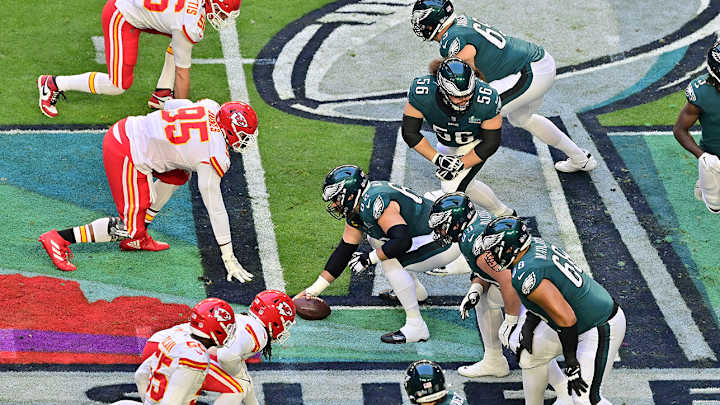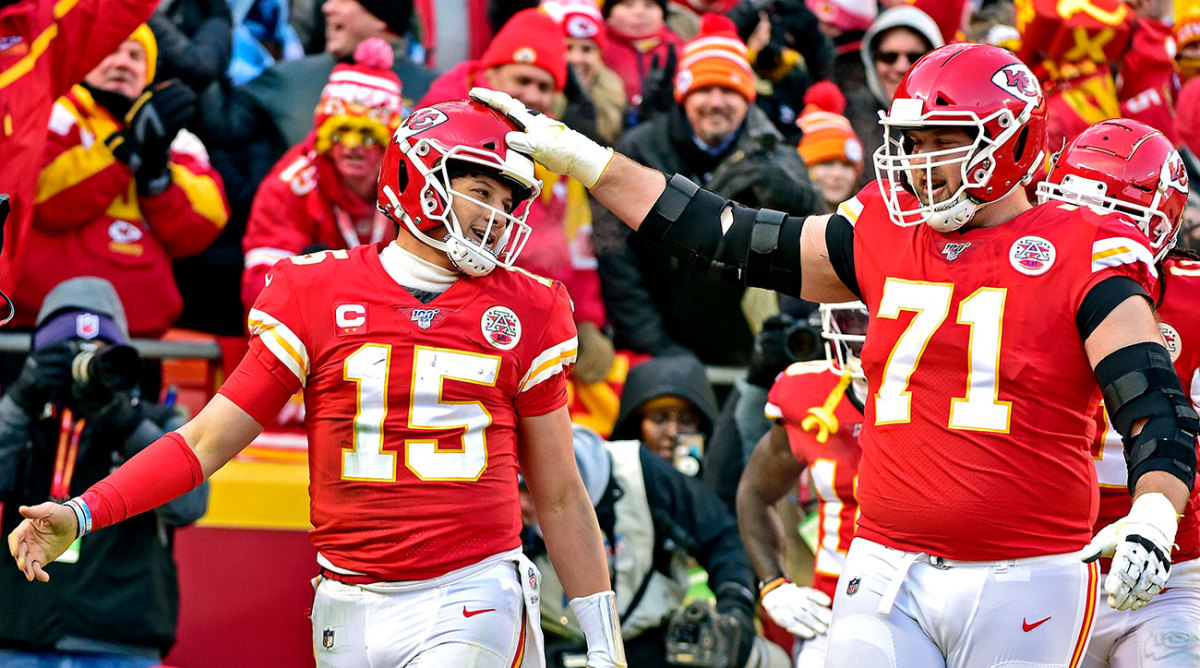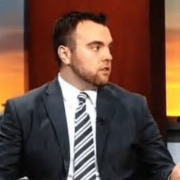How NFL Offensive Linemen Have Gotten Better at Timing the Snap

It was impossible to ignore. Jawaan Taylor wasn’t near the line of scrimmage.
During the NFL’s Week 1 opening game between the defending champion Chiefs and visiting Lions at Arrowhead Stadium, NBC announcers Mike Tirico and Cris Collinsworth pointed out the issue with Kansas City’s new right tackle repeatedly, and it quickly became a thunderstorm on social media.
In recent years, with edge rushers quicker and faster than ever before, tackles have begun cheating a bit off the line.

“[Illegal formation] has always been an issue, but I do feel the last two to three years this has been more of an issue,” says Dean Blandino, an NFL rules analyst for Fox Sports and the former NFL vice president of officiating. “I don’t know if you’ve got players who are really good at it or if officials aren’t being told to officiate the line of scrimmage as closely as they have in the past. The foul numbers would lead you to believe it’s on the officiating side a little bit.”
Blandino left his post with the NFL after the 2016 season.
“Foul numbers are down a little bit,” he continues. “Historically you average between 15 and 16 fouls per game. That includes both teams, accepted, declined, offsetting, everything. That number has dropped over the last couple of years closer to 13 per game, which is a low number. Then you look at the formation fouls. They were down last year as compared to 2021. I think it might be a combination of players like Lane Johnson and others who are really good, but we aren’t officiating the line of scrimmage as closely in years past.”
For clarity, the NFL rule book states that at least seven offensive players must be up on the line of scrimmage. This typically includes all five offensive linemen and then two skill-position players. For the linemen, they must have a body part breaking the imaginary line drawn sideline-to-sideline starting at the center’s belt. Usually, this is the helmet’s crown.
Looking back to TNF, @DeanBlandino breaks down the most talked-about rules debate of Week 1: was Jawaan Taylor set up illegally? pic.twitter.com/Z7RX8KSdj4
— The 33rd Team (@The33rdTeamFB) September 11, 2023
In Week 1, the league called only seven illegal formation fouls across 16 games. Then, after sending out its weekly teaching tape that concluded by featuring a slew of missed formation calls, including multiple would-be infractions by Taylor, the NFL blew the whistle on 10 in Week 2. Those included one on Taylor in Kansas City’s 17–9 win over the Jaguars.
While illegal formation is supposed to remain a point of emphasis moving forward, we’ve seen the NFL crack down on certain calls to send a message for a few weeks before relenting. Ultimately, nobody wants to see big plays brought back by minor penalties, which is why officials are taught to warn players before littering the field with yellow flags.
“They do have a lot going on,” Blandino says of officials watching for the snap. “There’s no question. They’re not just solely focused on the tackle. They’ve got to look at the alignment. They’ve got to look at the receivers and make sure there are seven on the line. Make sure an outside receiver isn’t covering up a slot receiver who is supposed to be off the ball. … With the tackles, we always talk about communication and preventative officiating. It is something they’re looking at, and they may go up and say, ‘Hey, 74, you’ve got to get up on the ball.’ No one wants the officials to be overly technical. I think the officials understand that.”
Still, there’s an unanswered question: Why are tackles suddenly appearing to get off the ball more quickly without being whistled for either a false start or an illegal formation on a consistent basis?
The answer lies in the details of line play.
“There’s been an emphasis on really getting off the ball on the silent cadence,” says Geoff Schwartz, a retired offensive lineman who played seven NFL seasons between the Panthers, Vikings, Chiefs and Giants. “When I was younger, we were taught as a tackle to look at the ball, and when the ball is snapped, you move. But you’re a little bit late when you do that, right? Now guys are taught that when the center puts his head up to snap, or when the guard throws his hand forward to alert the center, tackles have practiced the timing. When the center brings his head up, or when the arm goes forward, it’s one second from snap. They don’t even look at the ball anymore.
“When you watch the best centers in the NFL, it’s no wonder it’s the Eagles and Chiefs. Those centers [Jason Kelce and Creed Humphrey] are really good with their cadences. If you watch them, it’s very consistent and routine. The tackles … know the exact rhythm. One second, half of a second, it’s practiced so much now that this is what’s happening. It’s the perfection of the system, to use the cadence to your advantage.”
Speaking with Schwartz and his younger brother, Mitch, who played nine seasons with the Browns and Chiefs before retiring after the 2020 season, this isn’t about only the tackles.
While the tackles will always incur the penalty because they’re the ones lined up on the perimeter of the offensive line, much of the issue can be traced back to the guards.

“Tackles align off the guards, not the center,” Mitch Schwartz says. “They kind of know based on the guard alignment, based on what they see on film of themselves, whether the refs are telling them they’re too deep or not, how to align off your guards. Guards are the ones who play around more with how deep or shallow they are. So the tackle, for the most part, is relatively constantly relative to the depth of the guard, not the center.”
He also goes on to detail how every team has different preferences. When he was in Kansas City, the guards typically aligned halfway between the ball and the center’s belt; whereas in Baltimore, while All-Pro guard Marshal Yanda was playing, the Ravens liked to set deeper. In Philadelphia, the Eagles are notorious for being as far off the ball as possible.
For teams such as the Ravens and Eagles, it creates the illusion that the tackles aren’t far off the line, considering they’re even with the guards.
“It’s only upside,” says Geoff Schwartz of the additional space created. “The only downside is maybe you kick too far, so you kind of overset and allow guys to come inside. But the guys who are really good at it aren’t doing that. The reason it’s important to get off the ball is because you want to get to the point between the quarterback and pass rusher as soon as possible. When you do that, and you’re in good position, the defensive lineman doesn’t have much to work on.”
Then there’s the usage of silent counts.
For years, silent counts were used out of necessity with loud crowds making it tough for offenses to communicate at the line of scrimmage. And while this is still true, silent cadences are now being used in a variety of ways.
Mitch Schwartz noted an example of how his Browns utilized silent counts on third downs during the 2015 season. The Browns felt the strategy was an advantage with three stars on the offensive line, including him, tackle Joe Thomas and center Alex Mack. Cleveland trusted its chemistry, and the move gave them an advantage over defensive linemen, who couldn’t lock in on the quarterback’s cadence.
Ultimately, regardless of the method, the goal is to create a split second along with additional grass between the two lines. If that’s achieved and a flag isn’t thrown, the offense is at a meaningful advantage before the ball is put into play.
“Pretty much every offensive line coach teaches that contact is made on the second step,” Mitch Schwartz says. “So if I’m only a foot or two away from the defensive lineman, it’s really difficult to get my second step down before contact. Where if I’m deeper off the line, you get that second step down and the power behind you. That’s a more effective block.”
Going forward, how harshly the NFL continues to monitor illegal formation and tackle-guard depth will be worth watching. While warnings and the occasional flag are certain to come in the weeks ahead, should and will officials call enough penalties to force a change in the behavior overall?
In the league’s opening game and in Week 2, the problem was obvious, unavoidable and called out.
How the league officiates this moving forward may impact some of the best teams and biggest games.
